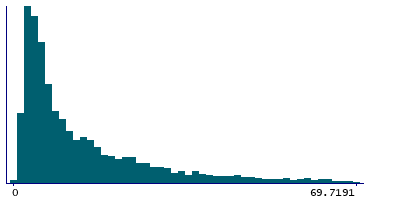Data
35,823 items of data are available, covering 35,823 participants.
| Maximum | 90.0489 |
| Decile 9 | 36.2082 |
| Decile 8 | 23.5765 |
| Decile 7 | 16.4156 |
| Decile 6 | 11.832 |
| Median | 8.70736 |
| Decile 4 | 6.41767 |
| Decile 3 | 5.01677 |
| Decile 2 | 3.80643 |
| Decile 1 | 2.69725 |
| Minimum | 0.676827 |
|

|
- Mean = 14.7326
- Std.dev = 15.225
- 376 items above graph maximum of 69.7191
|
Notes
The Scottish Index of Multiple Deprivation (SIMD) 2009 identifies small area concentrations of multiple deprivation across Scotland in a consistent manner. The SIMD combines data from seven distinct domains or topic areas all of which are considered to be important contributors to deprivation levels. These domains have remained the same as in the previous version of the index, published in 2006, and the data used in compiling each one is the most appropriate and up to date that was available at the time of constructing the index.
The SIMD is a relative measure of deprivation that uses 6,505 data zones across Scotland as its unit of comparison. The rank applied to each of these data zones identifies each as being more or less deprived than all the others in the country. The rankings run from 1 being the most deprived to 6505 being the least deprived. Therefore the smaller the ranking the more deprived the data zone. As the SIMD is a relative measure it cannot show how much more deprived one data zone is than another, e.g. that a data zone ranked 5 is twice as deprived as a data zone ranked 10. In the same way the distance between each ranking can vary - so the gap between the data zones ranked 16 and 17 could be very small while the gap between those ranked 17 and 18 could be much bigger.
The SIMD can be used to identify the small areas with the highest concentrations of multiple deprivation in Scotland using either the overall index or the individual domains. The most commonly used cut off levels are 10%, 15% or 20% - although different cut offs may be required depending on individual policy or organisational focus.


